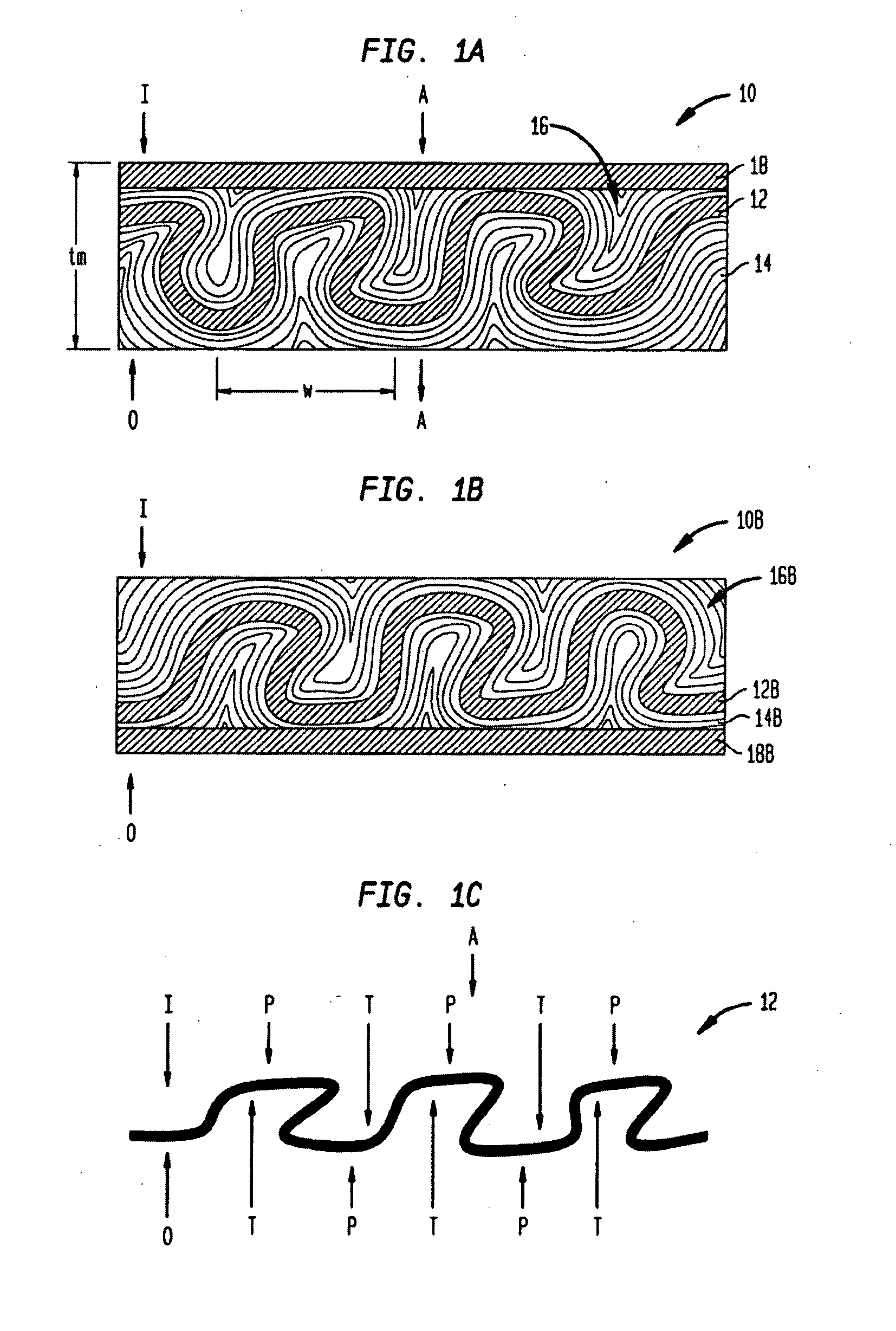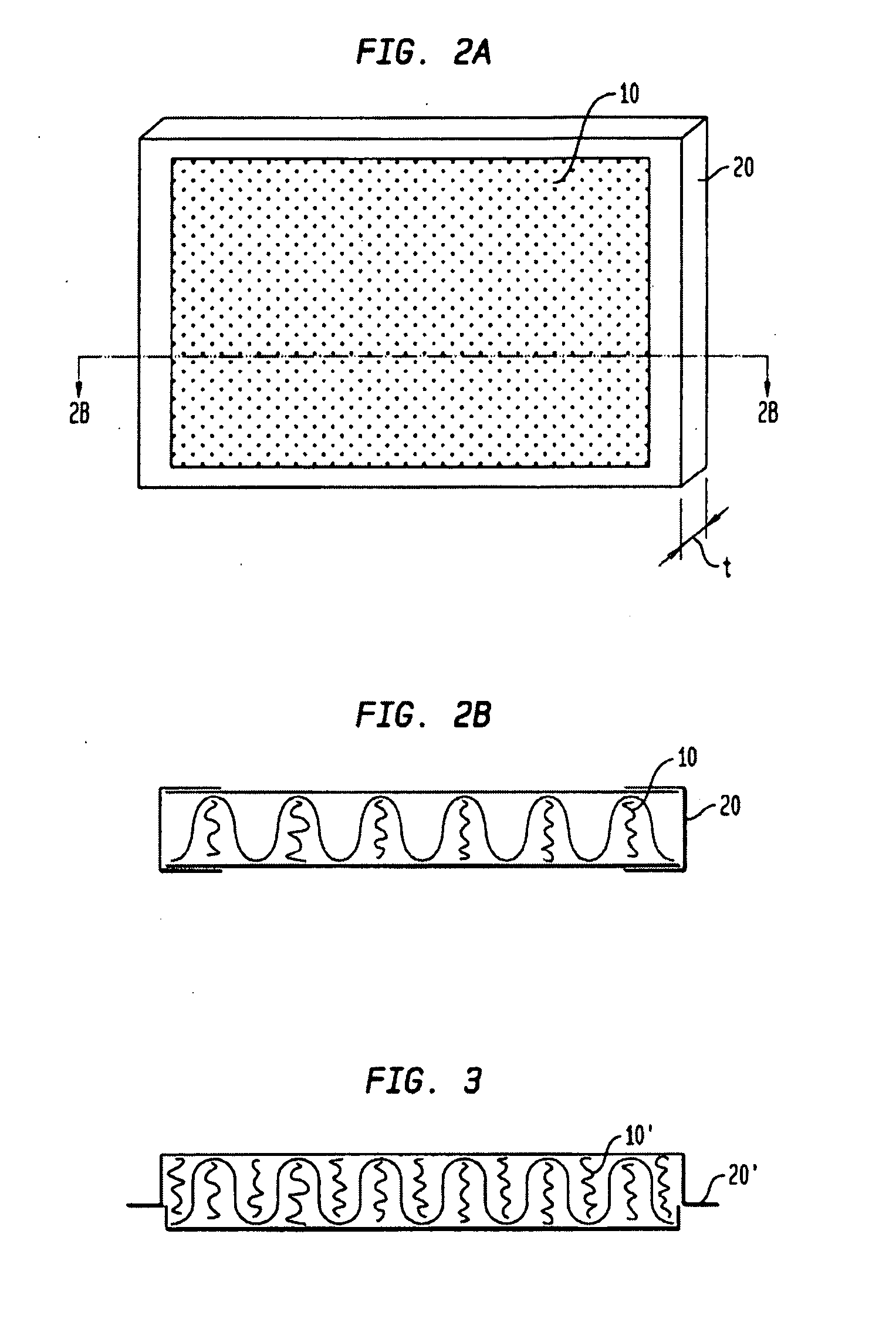Waved filter media and elements
- Summary
- Abstract
- Description
- Claims
- Application Information
AI Technical Summary
Benefits of technology
Problems solved by technology
Method used
Image
Examples
example 1
Comparative Sample A
Control
[0119]Sample A is a planar filter media that is manufactured by Johns Manville and sold as CM285B-2, and it is an 80-85% glass mat filter media. The properties of the media were tested and are listed below in Table 1 under Sample A.
[0120]For all samples prepared in Example 1, the DOP Penetration and DOP alpha were measured after discharging the media using isopropyl alcohol. In particular, the sample was placed in a container containing a 100% isopropyl alcohol solution, and allowed to soak for approximately 5 seconds or until full saturation was achieved. The sample was then removed from the solution and allowed to drain for approximately 30 seconds. The sample was then placed in a fume / vacuum hood and allowed to air dry. Drying time was greatly dependent upon the thickness of the sample, and varied from 20 minutes to 48 hours. The DOP Penetration and DOP alpha tests were then performed.
Comparative Sample B
Control
[0121]Sample B is a planar filter media th...
example 2
[0133]A first planar fine fiber meltblown layer, referred to as Meltblown C, was prepared having the same configuration as the fine fiber meltblown layer of Sample C. The basis weight of Meltblown C was 20 gsm.
[0134]A second planar fine fiber meltblown layer, referred to as Meltblown D, was prepared having the same configuration as the fine fiber meltblown layer of Sample D. The basis weight of Meltblown D was 20 gsm.
[0135]The NaCl loading for Meltblown C and Meltblown D, as well as for Samples C and D from Example 1 above, were tested and the NaCl Loading at 76 lpm is shown in FIG. 8. As shown, the waved filter media of Samples C and D show a significant improvement in NaCl loading, as the resistance remains low over a longer period of time, as compared to Meltblown C and Meltblown D.
example 3
Comparative Sample F
[0136]Sample F was formed using four layers, listed in order from upstream (air entry) to downstream (air outflow): (1) a top carded nonwoven layer, (2) a fine fiber meltblown layer, and (3) a downstream carded nonwoven layer.
[0137]The top and bottom nonwoven layers were formed from 45% of a 3 denier by 1.75″ Type 202 bicomponent fiber available from FIT, and 30% of a 3 denier by 2″ Type N39 PET fiber available from Poole. The top and bottom nonwoven layers were each bonded in an oven. The top and bottom nonwoven layers each had a basis weight of 160 gsm, a thickness of 155 mil, and an air permeability of 420 CFM.
[0138]The fine fiber meltblown layer was formed from a polypropylene fiber having an average fiber diameter of 1.1 μm. The basis weight of the meltblown layer was 35 gsm, the thickness was 11 mil, and the air permeability was 39 CFM.
[0139]The top and bottom nonwoven layers were positioned on opposite sides of the fine fiber meltblown layer to form a plan...
PUM
| Property | Measurement | Unit |
|---|---|---|
| Length | aaaaa | aaaaa |
| Length | aaaaa | aaaaa |
| Length | aaaaa | aaaaa |
Abstract
Description
Claims
Application Information
 Login to View More
Login to View More - R&D
- Intellectual Property
- Life Sciences
- Materials
- Tech Scout
- Unparalleled Data Quality
- Higher Quality Content
- 60% Fewer Hallucinations
Browse by: Latest US Patents, China's latest patents, Technical Efficacy Thesaurus, Application Domain, Technology Topic, Popular Technical Reports.
© 2025 PatSnap. All rights reserved.Legal|Privacy policy|Modern Slavery Act Transparency Statement|Sitemap|About US| Contact US: help@patsnap.com



